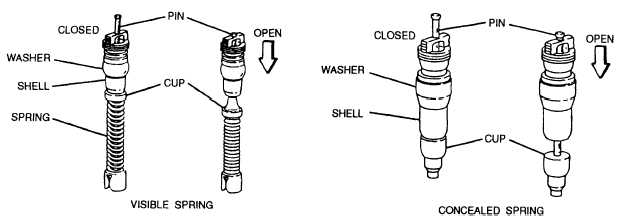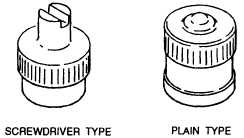Figure 3-12.—Valve cores.
UNDERINFLATED.— An underinflated tire is
shown in figure 3-11, view B. This tire does not contain
enough air for its size and the load it must carry. It flexes
excessively in all directions and gets hot. In time, the
heat weakens the cords in the tire, and it blows out.
Underinflation also causes tread edges to scuff the road
that puts uneven wear on the tread and shortens tire life.
Never run a tire flat, or nearly flat, unless the tactical
situation in combat requires it. When run flat for even a
short distance or almost flat for a long distance, the tire
may be ruined beyond repair.
OVERINFLATED.— An overinflated tire is
shown in figure 3-11, view C. Too much air pressure
also causes tire failure. Excessive pressure prevents the
tire from flexing enough and causes it to be constantly
subjected to hard jolts. When an overinflated tire hits a
stone or rut, the cords may snap and cause a break in the
cord body. The center of the tread wears more rapidly
and does not permit equal wear across the entire tread.
Hard riding from too much air pressure also increases
wear and tear on the vehicle.
Valves
For speed and convenience during inflation, valve
stems should be readily accessible. They should be
properly centered in the valve holes and slots to prevent
scraping against the brake drums. They should be placed
so the valves extend through the wheels. Valves on the
inside duals should point away from the vehicle, and the
valves on the outside duals should point toward the
vehicle. On dual wheels, the valve of the outside dual is
placed 180 degrees from the inside valve for speed and
convenience in checking pressures and inflation. With
this arrangement, the locations of the valves are always
known even when you are checking them in the dark.
Spare tires should be mounted so that the valve is
accessible for checking and inflating.
VALVE CORES.— The valve core (fig. 3-12) is
that part of the valve that is screwed into the valve stem
and permits air, under pressure, to enter, but prevents it
from escaping. Two types of valve cores and two sizes
of each type are in use today. The two types are the
visible spring type and the concealed spring type. The
two types are interchangeable. Two sizes are provided
for the standard bore and the large bore valve stems. The
core shell has a rubber washer that provides an airtight
seal against the tapered seat inside the stem. Directly
below the shell is a cup that contains a rubber seat,
which, in the closed position, is forced against the
bottom of the shell, forming an airtight seal. The pin on
top of the valve core, when pushed down, forces the cup
away from the shell, permitting air to flow.
VALVE CAPS.— The valve cap (fig. 3-13) is also
a component part of the valve and is screwed onto the
end of the stem, providing a second airtight seal. The
cap also protects the threads on the end of the stem and
Figure 3-13.—Valve caps.
3 -8



